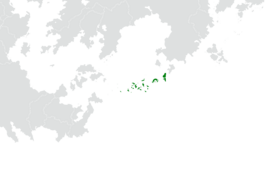Kajera
This article is incomplete because it is pending further input from participants, or it is a work-in-progress by one author. Please comment on this article's talk page to share your input, comments and questions. Note: To contribute to this article, you may need to seek help from the author(s) of this page. |
Republic of Kajera | |
|---|---|
|
Flag | |
| Motto: "Tual, tumane, tuemeaole." "For sun, for sea, for memory of all." | |
| Anthem: Buledoldanna "Bluewater Ode" | |
 Location of Kajera on Earth. | |
| Capital | Rimae |
| Official languages | Kajeran |
| Recognised national languages | |
| Demonym(s) | Kajeran |
| Government | Unitary parliamentary republic with an executive presidency |
• President | Sabana Lokilone |
• Speaker | Hale Maron Nejinikor |
| Legislature | Konkomman |
| Area | |
• | 75,104 km2 (28,998 sq mi) |
| Population | |
• 2020 census | 32,010,871 |
• Density | 426.2/km2 (1,103.9/sq mi) |
| GDP (nominal) | 2019 estimate |
• Total | $784,266,339,500 |
• Per capita | $24,500 |
| Gini (2019) | 20.3 low |
| HDI (2019) | very high |
| Currency | Kajeran tala |
| Time zone | UTC |
| Date format | dd/mm/yyyy |
| Driving side | right |
| Calling code | +82 |
| Internet TLD | .ka |
Kajera (insert pronunciation guide later IPAC), officially the Republic of Kajera, is a country in eastern Malaio. Its population of 32,010,871 people is spread out across 14 islands and 21 coral atolls, comprising 1,131 individual islands and islets. It shares maritime boundaries with Daobac to the north, Pulau Keramat to the northwest, and Onekawa-Nukanoa to the southwest. Kajera's capital and largest island is Rimae. It has one of the largest portions of territory composed of water of any sovereign state in the world. Approximately 40% of the population are defined as being 'urban,' with a significant population (26%) of semi-nomadic seafaring groups.
Seafarers from continental Malaio and Ochran first reached the islands circa the second millennium BC, utilizing stellar navigation techniques as well as swell formations to find their way between atolls. The area that is now Kajera was fully settled by the ninth century BC. The Tahamaja Empire incorporated the islands in the late eighth century AD, with Kajera becoming one of the empire's premier economic and political hubs. Following the Siriwang Eruption and the subsequent collapse of the Tahamaja, the islands fell into a brief period of anarchy that was stopped by the consolidation of power by former Tahamajan admiral Laina Tiimaja. The majority of the islands remained independent for the duration of the Mutulese Ochran. Republican movements began in earnest with the waning of Mutulese power in the late 18th century, and in 1825 the area was unified as the Republic of Kajera.
Kajera is a unitary parliamentary republic with an executive presidency. The Kajeran economy is based mainly around tourism, fishing, and small-scale agriculture, with one of the largest tourist industries in the region. It is a member of the Association of Ozeros Nations and the Vespanian Exchange Institute and holds strong sociocultural ties with its neighbors, both immediate and extant. Kajera consistently ranks highly in evaluations of overall quality of life, minority protections, and environmental stewardship, and is considered one of the foremost nations in terms of LGBT rights.

